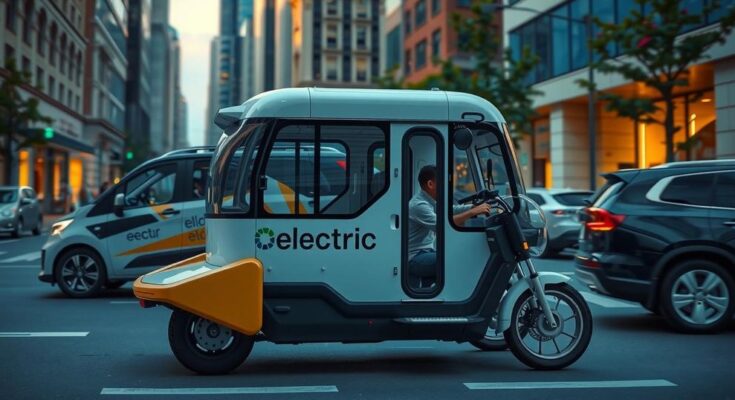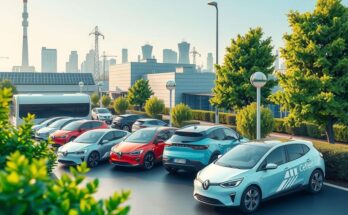The logistics industry is witnessing a shift towards electric 3-wheelers for last-mile deliveries as they offer economic benefits over ICE vehicles. While electric models have a higher initial cost, reduced running and maintenance expenses lead to significant savings. Government incentives play a crucial role in making electric vehicles more attractive. Despite challenges like battery costs and charging infrastructure, electric 3-wheelers offer a viable and sustainable alternative in urban environments.
The logistics landscape is shifting towards electric last-mile deliveries with L5 electric 3-wheelers, challenging traditional internal combustion engine (ICE) vehicles. As fuel costs rise and sustainability concerns grow, businesses recognize the operational and economic benefits of electric options. To fully understand the financial merits, one must assess various factors such as purchase prices, running costs, maintenance, and overall profitability for fleet operators. Electric 3-wheelers typically cost more initially than ICE counterparts; electric models range between INR 3.5 to 4 lakhs, while ICE vehicles are priced at INR 2.0 to 2.5 lakhs. However, subsidies under initiatives like India’s PM E-DRIVE can mitigate this upfront cost, bringing electric options closer to ICE pricing. These incentives have made the transition to electric vehicles more feasible for businesses. When evaluating running costs, electric 3-wheelers shine brightly. With operational expenses for electric vehicles around INR 50-60 for 100 kilometers, compared to INR 250-300 for ICE vehicles, businesses can see substantial annual savings of INR 60,000-90,000 per vehicle. Such dramatic reductions enhance the allure of electric 3-wheelers, particularly as fuel prices fluctuate. Maintenance is another area where electric 3-wheelers excel, requiring significantly less upkeep due to fewer moving parts. While ICE maintenance can cost between INR 3,000-5,000 monthly, electric vehicles usually only need INR 1,000-2,000. The simplicity of electric powertrains and regenerative braking further minimizes service interruptions, maximizing fleet efficiency. However, battery costs pose challenges for electric 3-wheelers. While lithium-ion batteries last approximately 5-7 years with a replacement cost of INR 1.0-1.5 lakhs, advancements may reduce these prices. Moreover, battery recycling initiatives could alleviate some negative impacts associated with battery disposal, improving electric vehicle economics as technology progresses. Government incentives, including lower Goods and Services Tax (GST) for electric vehicles, further encourage their adoption. Various state-level benefits and subsidies ease the financial shift and keep electric 3-wheelers competitive. Additionally, electric vehicles contribute to reduced emissions, combatting air pollution and enhancing urban life quality with their quiet operation. Despite their advantages, electric 3-wheelers face challenges such as range anxiety and underdeveloped charging infrastructure, especially in rural areas. Battery swapping technology is emerging to counteract these issues by allowing operators to exchange depleted batteries for charged ones quickly, reducing downtime and broadening the utility of electric vehicles. Looking towards the future, the role of electric 3-wheelers in last-mile logistics will likely increase as their operational cost advantages and eco-friendly profiles resonate more with businesses. In areas still lacking charging infrastructure, ICE 3-wheelers may retain relevance, but a hybrid fleet approach often emerges as a pragmatic solution for logistical companies operating across various terrains. As advancements in battery technology and charging infrastructure continue, integrating electric vehicles into logistics will not only provide financial benefits but align with broader sustainability initiatives.
The growing interest in electric vehicles, particularly in last-mile logistics, stems from increasing fuel prices and heightened environmental awareness. The logistics industry is adapting to changing consumer preferences and stringent regulations, prompting a switch from traditional ICE vehicles to electric models. Understanding the economic implications of this transition is essential for fleet operators as they evaluate operational costs and efficiencies between electric and ICE 3-wheelers.
As electric 3-wheelers carve out their niche in last-mile delivery services, their economic and environmental advantages become increasingly clear. With government subsidies, reduced running and maintenance costs, and technological advancements improving battery economics, the case for adopting electric vehicles grows stronger. While challenges remain regarding infrastructure and range, the future holds promise for widespread EV adoption in logistics, fostering a shift towards sustainability.
Original Source: evreporter.com



